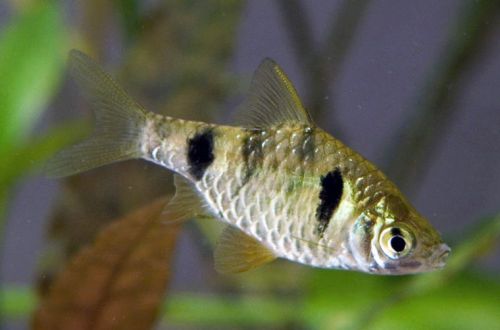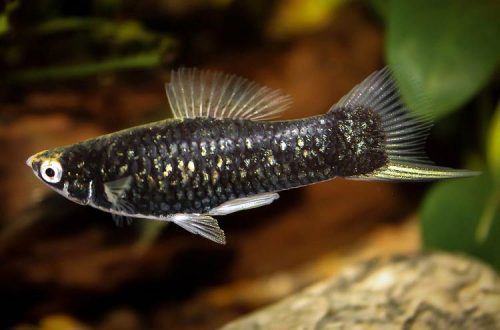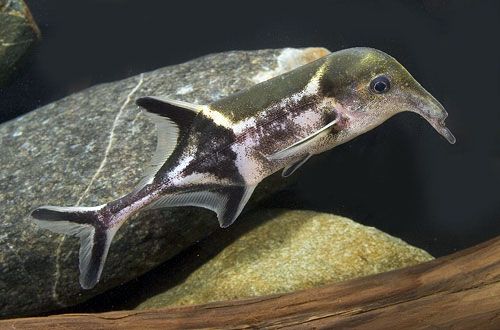
Dwarf Barbus
Barb Futunio or Dwarf Barb, scientific name Pethia phutunio, belongs to the family Cyprinidae (Cyprinidae). Miniature fish, easy to keep and breed, compatible with other species of comparable size. Considered a good choice for beginner aquarists.

Contents
Habitat
Occurs from the territory of the eastern part of India and Bangladesh. It lives in the lower reaches of the Ganges and Brahmaputra rivers. The natural habitat is a vast swampy area with an abundance of aquatic vegetation. The flow in these reservoirs (swamps, backwaters, lakes) is weak, the substrates consist of silt and mud and are littered with fallen trees, branches, etc.
Brief information:
- The volume of the aquarium – from 50 liters.
- Temperature – 21-26°C
- Value pH — 6.0–7.0
- Water hardness – 3–12 dGH
- Substrate type – any soft dark
- Lighting – any
- Brackish water – no
- Water movement is weak
- The size of the fish is up to 3 cm.
- Feeding – any food of suitable size
- Temperament – peaceful
- Keeping in a group of 8-10 individuals
Description
Adults reach a length of only 3 cm. The color is silvery with a yellow tint on the back. The body pattern consists of two black strokes located alternately at the head and tail. Sexual dimorphism is weakly expressed, it is problematic to distinguish a male from a female.
Food
An omnivorous species, in a home aquarium it will accept most popular foods of a suitable size. At least once a week, it is recommended to serve live or frozen foods such as bloodworms or brine shrimp.
Maintenance and care, arrangement of the aquarium
The optimal size of the aquarium for a small flock of these fish starts from 50 liters. The design is arbitrary, however, the fish will look more harmonious in an environment reminiscent of its natural habitat – dark soft ground and a large number of aquatic plants, including floating ones. The lighting is subdued. It will not be superfluous to add dry leaves, which, in the process of decomposition, will give the water a characteristic brown color. More details in a separate article “The leaves of which trees can be used in an aquarium.”
The maintenance of Futunio Barbs is quite simple and does not require large financial and time costs. Maintenance is standard and consists of several procedures: weekly replacement of part of the water with fresh water, regular cleaning of organic waste, preventive maintenance of equipment, monitoring of pH / dGH / oxidizability parameters.
Since the fish do not tolerate strong currents, when choosing a filter, you should choose models that do not cause excessive movement of water.
Behavior and Compatibility
Peaceful schooling fish. Due to the modest size of the Dwarf Barb, the choice of tankmates should be taken with great care. Any large and even more aggressive fish should be excluded. It is recommended to maintain in a group of at least 8-10 individuals.
Breeding / breeding
Breeding is similar to other Barbs. During the spawning period, females scatter eggs in the water column, and males fertilize them. From the moment the eggs sink to the bottom, they become left to themselves. The incubation period lasts up to 2 days, after another 3-4 days the fry begin to swim freely. Parental instincts are not developed, so adult fish, on occasion, will certainly eat their own offspring. For this reason, the survival rate of fry in a common aquarium is minimal.
You can save the brood if you transfer the eggs and fry that have appeared to a separate tank with identical water conditions. This impromptu spawning aquarium is equipped with a simple airlift filter with a sponge and a heater. A separate lighting system is not required. In the early days, you should feed with microscopic food, such as shoe ciliates, as they grow older, Artemia nauplii or specialized powder food for aquarium fish fry can become the basis of the diet.
Fish diseases
In a balanced aquarium ecosystem with species-specific conditions, diseases rarely occur. Diseases are caused by environmental degradation, contact with sick fish, and injuries. If this could not be avoided, then more about the symptoms and methods of treatment in the section “Diseases of aquarium fish”.




